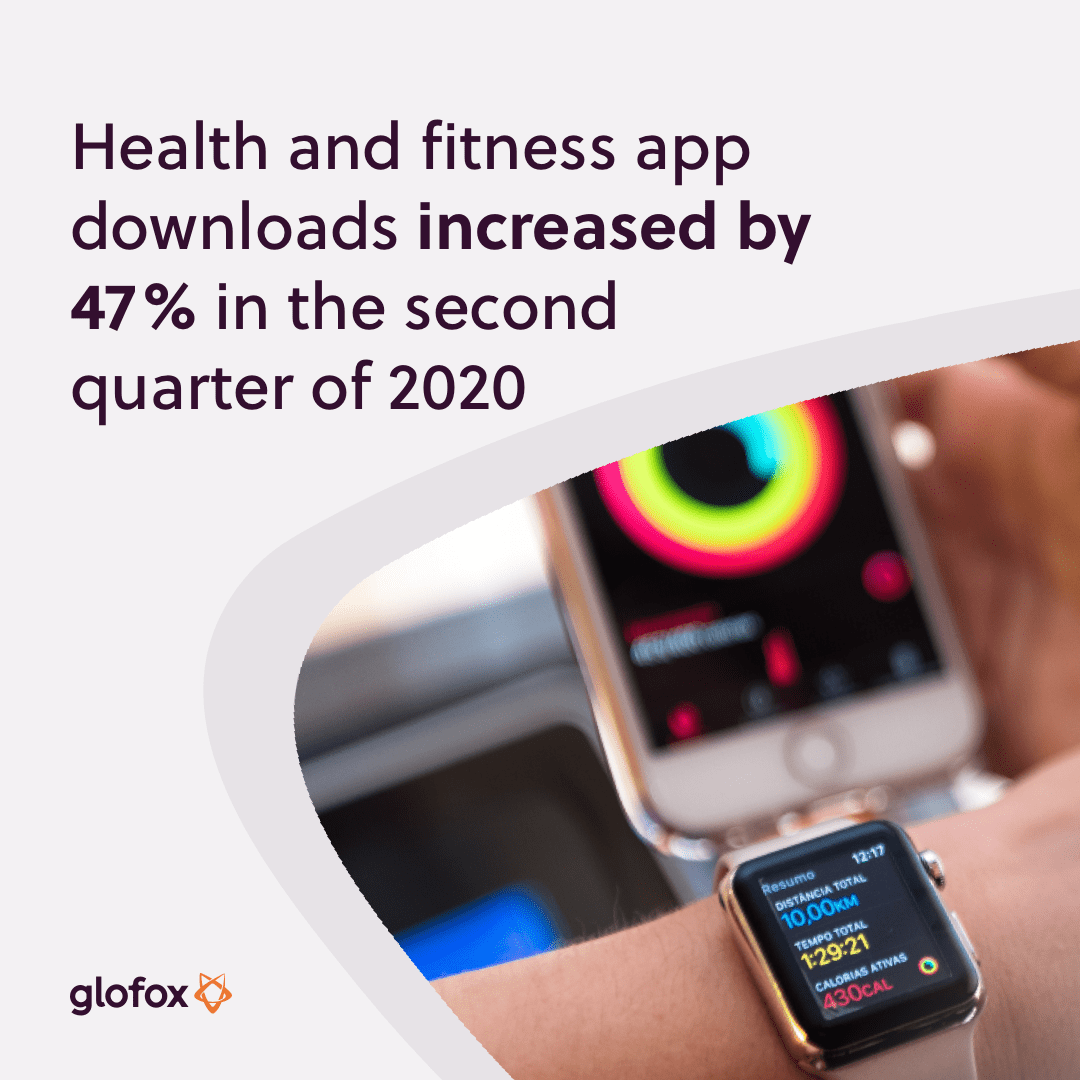The global health market is worth about $94 billion, with an annual growth rate of 4.5%. This number doesn’t even consider other industries like wearables, activewear, and other fitness products. The fitness market looks set to continue to grow, but how will the coronavirus crisis impact the fitness industry? With massive spikes in home-workout equipment and increased awareness of health and fitness, the fitness industry has had to adjust to a new normal.
Gyms and studios will need to navigate this new normal to meet consumer demand and expectations; members have come to expect a certain offering. As digital fitness continues to skyrocket, it’s clear the pandemic has changed the fitness market forever. In this article, we look at the trends shaping the fitness market and what to expect in the future. Skip ahead to:
- Post-COVID-19: What Trends Will Shape the Fitness Industry?
- What Will the Fitness Market Look Like in the Future?
Post-COVID-19: What Trends Will Shape the Fitness Industry?
The United States is one of the world’s largest health and fitness markets. Consumers are engaging more and more with fitness and wellness brands to live a healthier life. While the need for fitness is obvious, businesses have had to pivot their services to deliver their offerings in a remote and socially-distant way. This has paved the way for a new era of digital fitness. Let’s break down what trends will shape the fitness market in the future and how this will impact the industry as we know it.
1. Awareness in Health and Fitness
One of the driving factors behind the fitness industry is the growing awareness of health and fitness. During lockdown, the news and media provided almost daily reminders for regular exercise, especially as poor cardiovascular health is a risk factor for severe illness from the coronavirus. Governments from all over the world encouraged nations to move more in a bid to improve public health. This will have a lasting effect on consumer’s minds to stay fit and healthy.
2. Massive Rise in At-Home Fitness
The home fitness revolution has been going on for decades, but recent events have caused a massive spike in home-fitness. In March, gyms closed all over the world. Many people turned to apps, fitness streaming services, YouTube, and Zoom to get their fitness fix. Consumers are getting serious about home fitness. For example, in the US, fitness equipment sales shot up 55% between March and June. The lure of the gym will be too strong for some to ignore. However, there has been a shift in mindset on what home fitness can help you achieve; it is much more complicated now, and people expect more from their home workout experience.
3. Crisis Has Accelerated Shift to Digital Fitness
Back in March, Peloton app downloads increased fivefold. Health and fitness app downloads increased by 47% in the second quarter of 2020. The running and cycling app Strava has benefitted massively with installs shooting up 179.2% from January to May.
Virtual workouts, streaming, and on-demand fitness existed before the COVID-19 crisis. What’s changed is that fitness businesses have had to shift quickly to digital fitness to generate income. This will shape the future of fitness both in the short-term and long-term. If you can future-proof your business to withstand a pandemic, you can successfully create multiple income streams and grow your brand.
4. Technology-Centered Solutions
Technology will continue to be a massive influencer in the fitness market. Brands are leveraging technology to provide immersive and innovative fitness experiences. From wearable and fitness trackers to smart clothing and home equipment, technology has a significant role to play in the future of fitness. With the ability to enhance workouts’ efficacy, gyms can offer a higher personalization level to shape member’s active lifestyles and gym experience.
5. Increase in Hygiene and Cleaning
Gyms and fitness centers face a massive increase in hygiene and cleaning procedures off the back of the coronavirus pandemic. To minimize the risk of transmission and reduce the spread of COVID-19, businesses need to find ways to follow guidelines and retain social distancing measures. Although it’s unclear how long these measures will need to be in place, it looks to influence the fitness industry.
People are looking for fitness environments that can be easily controlled and managed. Therefore, a smaller boutique studio may be more attractive than a big-box alternative. With more people deciding where to workout based on the COVID measures in place, the fitness industry may need to cater to this going forward.
In this episode of The Fitness Founders Podcast, we’re joined by Industry leader Emma Barry. Emma has worked with marquee fitness brands such as Equinox and Les Mills.
Check out the episode below for Emma’s insights on pivoting to a digital offering, and the future of boutique fitness:
What Will the Fitness Market Look Like in the Future?
The fitness industry isn’t showing any signs of slowing down. Technology has given many fitness brands the ability to continue to connect and serve members throughout the pandemic. In a world that values experience and community, we look at what’s in store for the fitness industry.
1. Immersive Experiences
Some gyms are already taking fitness a step further by creating a fully immersive fitness experience. In the hopes of producing a better workout, brands are using innovative imagery and lighting to enhance the class. Things like temperature, terrain, color, and lighting can all play a part when working out. As technology advances, the ability to create immersive experiences will become stronger.
The global fitness program Les Mills uses a cinema-scale screen and sound in THE TRIP™. It’s a fully-immersive 40-minute stationary cycling session that takes you on a journey through digitally-created worlds. The experience is inspired by cinema and interactive games to motivate users to achieve results.
2. AI-Enabled Technology
Technology continues to be a key player in the future fitness industry. As innovations continue, artificial intelligence could transform fitness further in the next decade or so. AI technology is already transforming the fitness industry by making gadgets, software, fitness equipment, and mobile apps smarter.
This kind of tech has a place in all parts of the business. From customization to marketing and sales, technology is becoming smarter and re-shaping daily habits. We’re already seeing AI-based personal trainers, smarter wearables, and performance enhancements, but this is just the beginning. Artificial intelligence has the potential to be applied to a ton of products and services in the fitness industry to optimize and grow your business.
3. Fitness and Wellness Continue to Merge
The wellness market includes everything from boutique fitness clubs and spas to nutrition and personal training. The industry is valued at a massive $4.5 trillion, according to the Global Wellness Institute. Wellness is a broad term, but it’s classed as activities that promote mental and physical well-being.
As people incorporate more wellness into their lifestyle, fitness and wellness will continue to merge. Businesses can capitalize on this by providing premium services with a holistic approach to fitness. Wellness continues to be a dominant factor in the market with fitness facilities providing more than just exercise. For example, Equinox combines high-end fitness with luxury wellness and spas to create a premium experience for members.
4. Home Fitness Skyrockets
During the coronavirus pandemic, home fitness increased significantly in popularity. With many people having to find ways to work out from home, fitness app downloads rose significantly. The combination of apps, wearables, technology, and home fitness equipment means that people can effectively work out from home.
It remains unclear how many people will feel about stepping back into the gym. This opens the door to streaming platforms, fitness apps, and in-home gym solutions paving the way for the future of fitness.
5. Emphasis on Social Fitness
In a time where people have felt isolated and alone, the emphasis on social fitness is more significant than ever. Many people join a health club or studio to exercise with others and feel a sense of belonging. The social element of movement will continue to influence the fitness market.
Your gym’s community is a big selling point for potential new members. It’s essential to create an online and offline community that allows members to connect. This is something businesses will need to take into account. You can already see this in how boutique studios create social spaces like cafes and lounges to encourage members to connect.
6. Digital Fitness Platforms
COVID-19 has accelerated the digital fitness boom. Health-conscious consumers are turning to at-home fitness to stay fit and healthy. Because of this, digital fitness has increased massively and looks set for a fast-growing future.
Digital fitness platforms have allowed traditional gyms to enter into a hybrid business model. By running both digital and physical parts of the business, brands can tap into a larger audience and generate multiple income streams.
7. Smart Home Fitness Technology
The home gym is due a makeover. With high-tech smart home fitness equipment, the home gym of the future is set to look a little different. Busy schedules and long working hours mean that consumers are leaning towards home workouts without the commute or queues.
Digital innovation and technology, combined with space limitations, drive the demand for effective and smart home fitness technology. Brands are already capitalizing on the shift to smart home fitness equipment. Lululemon recently purchased home-fitness technology start-up Mirror for $500 million. According to Lululemon, Mirror is on track to generate $100 million in sales in 2020.
8. Convenient and Flexible Fitness
As on-demand fitness continues to spike, consumers’ demand for convenience skyrockets. Modern society craves convenience and flexibility in all areas, and fitness is no different. The ability to be able to work out when and where you want is very attractive.
In a world where you can find out information on your smartphone in a matter of seconds when something is slow and difficult, people won’t use it. The fitness experience will continue to be shaped by the consumers’ needs for complete convenience and flexibility.
9. Seamless Booking Experience
Seamless customer transactions are crucial to retaining members and attracting new ones. The booking experience is a key part of the overall fitness experience. Some industries are already using artificial intelligence to create a seamless experience in the form of chatbots.
Brands like ClassPass have already made the booking experience as simple as checking Instagram. More businesses will continue to leverage AI to analyze member history, make smart suggestions, and provide a smooth booking experience in the years to come.
10. Virtual Fitness
Virtual reality is an exciting area of the fitness market. It has the potential to be huge for both home fitness and boutique studios. New technologies could take the fitness world by storm. True virtual reality barely scratched the surface in 2019. But the industry is growing fast and for a good reason.
With the interconnected nature of VR headsets, tracking health metrics could become even more accessible to users through virtual reality technology. VR gamifies fitness and provides an immersive experience that could benefit users by encouraging movement and exercise. One brand making full use of VR is Black Box VR. The virtual reality gym takes immersive fitness to a new level. While virtual reality is already present in the fitness market, its future applications are unclear, but they can make a big splash in the industry.
11. Wearable Technology
Even though it feels like wearable technology has been around for years, you may be surprised to hear just how well the trend has taken off. The wearable technology market share was worth over $50 billion in 2019. The market size has doubled since 2014. What started as the original Fitbit band has now ballooned into an industry that helps you to live a healthier, more efficient life.
Looking to the future of fitness, wearable technology has the potential to optimize performance and exercise fully. This means delivering the most effective workout possible based on real metrics that can be fully customized. Things like smart shoes, smart jewelry, and more complex smartwatches could appear in the future.
In Summary
No one can predict the future or what the fitness market will look like in five years’, let alone 30 years’ time. But it’s clear than the pandemic has accelerated digital fitness in a way that may transform the industry forever. Technology continues to influence the market making home fitness more effective and achievable for everyone. As new trends come and go, the consumer mindset will continue to drive the fitness industry now and in the future.















